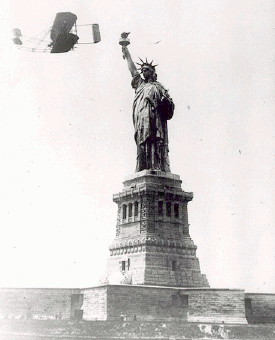Wright Brothers flights of 1909 facts for kids

The Wright brothers, Wilbur and Orville, are famous for their first successful airplane flight in 1903. But Wilbur Wright also made other important flights. In 1909, he was asked to fly his airplane in New York City. This was part of the Hudson–Fulton Celebration, which honored 300 years of New York history. The celebration remembered Henry Hudson exploring Manhattan and Robert Fulton starting steamboat service on the Hudson River. The organizers wanted to show off new aviation technology. Orville was busy in Germany, so Wilbur took the job. He had just finished training pilots for the U.S. Army.
Contents
Amazing Flights in New York
Another famous pilot, Glenn Curtiss, was also supposed to fly. Curtiss had recently set a world speed record for airplanes. The Wright brothers had actually sued Curtiss for using their airplane control ideas without permission. People were excited to see these two pilots fly. It was like a big competition!
Flying Over New York Harbor
Both pilots were scheduled to fly from Governors Island in New York Harbor. On September 29, Wilbur took off at 9:15 AM. It was quite windy. Curtiss felt the wind was too strong for his plane and decided not to fly. Wilbur, however, was confident. He reportedly told Curtiss, "It looks pretty good. I think I will take a little spin in a few minutes." Wilbur flew for about two miles, which took a little over seven minutes.
Later that day, Wilbur flew again at 10:18 AM. He flew over the large ship Lusitania and many other boats. These boats were there for the celebration. They blew their horns and whistles as the airplane flew overhead. Wilbur then flew towards the Statue of Liberty. Many people watching were worried he might crash. But he skillfully circled the statue, just as he had planned. This flight was a huge sensation. It was talked about everywhere, even though it lasted less than five minutes.
Curtiss still could not fly because of the wind. He had to leave for St. Louis for another event. He had planned to fly several miles up the Hudson River and back.
The Airplane with a Canoe
Wilbur knew that landing an airplane on water could be dangerous. If his engine stopped, the plane's landing skids would hit the water hard. This could throw him forward into the wires of the plane. The wooden and cloth wings would also sink quickly. He might get trapped before he could get out.
So, when Wilbur arrived at Governors Island, he and his mechanic, Charlie Taylor, made a clever change to the airplane. They attached a bright red canoe under the lower wing! Wilbur had bought this canoe a few days earlier. It was a strong, lightweight canoe made of cedar wood. It weighed about 60 pounds.
Wilbur chose this canoe because it was light and strong. It also had a good shape for cutting through the air. To make it even more aerodynamic, he removed a passenger seat from the plane. He also sealed the top of the canoe with canvas to keep water out.
This canoe turned Wilbur's airplane into the world's first floatplane. Wilbur hoped the canoe would keep the plane afloat if the engine failed. He also hoped it would keep the plane upright as it landed on the water. This would give him time to get out safely. He even had a life vest next to him. This shows how carefully Wilbur planned for every possible problem.
A problem with the engine later that day stopped any more flights. These flights were the last time Wilbur flew for a public audience.
"It was an interesting trip, and at times rather exciting."
Long Flight Up the Hudson
On Monday, October 4, Wilbur took off again at 9:53 AM. He flew north over the Hudson River, along the west side of Manhattan. He passed Grant's Tomb and then returned the same way. This flight was 21 miles long and took 33 minutes. He landed safely back on Governors Island. About a million people watched this amazing flight! This was the exact flight that Curtiss had been unable to make. Just like before, Wilbur had the red canoe attached to the bottom of his airplane for safety.
After Wilbur's death in 1912, his brother Orville kept the canoe. He placed it at Hawthorn Hill, his home in Oakwood, Ohio, as a special memory. This first airborne canoe is now at Carillon Historical Park in Ohio. It is displayed near the Wright Flyer III airplane.
In 2003, a group called Dayton 'Wright B Flyer, Inc.' recreated Wilbur's flight around the Statue of Liberty. They used a replica of the Wright airplane. This was part of the celebrations for the 100th anniversary of the Wright brothers' first flight.

